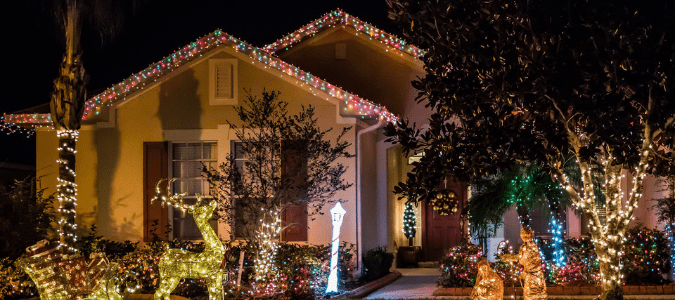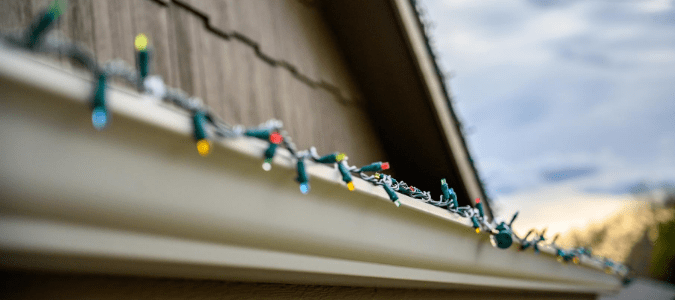
Do you dream of creating a holiday wonderland at home at Christmastime, complete with lights galore to capture the warmth of the season? Many of us do, but that heartwarming vision of twinkling lights might immediately be followed up with questions about what your electricity bill will amount to if you go with an extensive festive display. After all, with people coming and going, and running your heater during the wintertime, you may not know exactly how much electricity Christmas lights use.
With the holidays already being an expensive time of year, a high electric bill can certainly dim the festive cheer of an extensive lights display. Fortunately, a home Christmas lights display might be more affordable than you think, and there are several ways to limit your electricity use while still putting on a show the neighbors will remember for years to come.
It’s to be expected that a few weeks’ worth of holiday lights will increase your electricity usage, and therefore the charges on your utility bill—but exactly how much will your bill go up? When trying to calculate energy costs, remember first that size matters. If you use light strands with larger bulbs, your energy use will typically be higher than using strands with smaller bulbs. Many people like to use larger bulbs outdoors, but connecting enough strands of these bigger lights to illuminate your roofline and outline your front door will cost more than it would to use the same number of strands of mini-lights.
Furthermore, the type of lights you use matters. Those larger bulbs are often, though not always, traditional incandescent lights, which use more energy than LED bulbs—about six times more, on average. And the majority of the energy used in powering incandescent lights is burned off in the form of heat, which is why these lights are also known for being potential fire hazards, depending on where you hang them. Some people prefer incandescents for the tone and quality of the light they emit, but it’s important to exercise care if you’re using them either indoors to light your Christmas tree or outdoors to illuminate your home.
LED lights “burn” far cooler than incandescents, since they emit mostly visual light, making them a safer choice for holiday lighting. They are also available in a variety of sizes, colors and shapes, from tiny pinpoints of light to larger globe- or teardrop-shaped varieties that look more like those larger, traditional Christmas lights many people favor for outdoor displays. While LEDs may cost a bit more per strand than incandescents, they make up for that in energy savings, which translates to lower electricity bills. They are also longer-lasting than incandescent lights (often 30 to 50 times longer!), which means you can use them again, season after season.
So, how much electricity will your Christmas lights use, and how much will it cost? The exact wattage of most holiday light strands is listed on the package, making it relatively simple to calculate a rough estimate of how much it will cost to run your holiday lights at Christmastime. You’ll need to figure out how many strands you’ll use, how many hours you’ll turn on the lights each night and how much you typically pay for one kilowatt hour of energy use.
Many people turn on their Christmas lights displays around 5:00 PM during the holidays and then turn them off five hours later, around 10:00 PM. Keeping in mind this average of about five hours of use per day, multiplied by a total of about 30 days of use (or one full month spanning Christmas), that works out to around 150 hours of use over the holiday season. You can refer to your electric bill to find out how much your local electric company charges for one kilowatt hour of energy use, and then multiply that by the wattage of however many lighting strands you’re using. This will give you a general dollar amount per light strand that you might expect to pay for your Christmas lights display on your post-holiday electricity bill.
To break it down a bit further: A single strand of incandescent lights might cost around $10 to run for a month, depending on how many hours it’s turned on each day, while a single strand of LED lights should cost just $1 to $2 per month. Multiply those dollar amounts by the number of strands used in total, including those on the Christmas tree plus any strands used outdoors to light up the house or the trees and foliage, and it quickly becomes clear that LED lights are the way to go for cost-conscious lovers of Christmas lights displays, once you factor in any additional up-front costs.
If you love Christmas lights, but want to be more energy efficient this holiday season, you can find a place to recycle old incandescent lights and purchase LED lights, as well as reduce the number of hours you keep the lights on each day. If you want to minimize your spending during the holiday season, you can also cut down on the total number of strands you use by being judicious in where you put up the lights. Even homeowners on a budget often find that these simple cost-saving methods can justify hiring a professional to install their holiday lights. Hiring a Christmas lights installation company makes decorating easy, freeing you up to spend more time with your family during the holiday season, which many of us find is worth every penny.
Previously, we had mentioned that LED lights can last much longer than incandescents. Keep reading to learn just how much longer this type of lighting can last and what helpful safety tips you can keep in mind when planning your lights display this holiday season.

How Long Do LED Lights Last?
If you’ve ever used old-style incandescent Christmas lights during the holiday season, you probably noticed a corresponding higher electricity bill once the season ended, especially if you had an extensive outdoor display. This is because incandescent lights use more energy than LED lights—as we mentioned earlier, about six times more, generally speaking. Considering that LED lights use less energy, it follows that they should last longer than incandescents—so exactly how long do LED lights last?
The usual, general rule of thumb for how long LED lights last is about 50,000 hours. If you turned on your Christmas lights for the usual average of five hours a day, this would translate to well over 20 years of use—even if you lit them every single day of the year! Of course, there are certain factors that can limit the lifespan of LED lights. One of the main factors that can shorten LED lights’ lifespan is ambient heat; higher temperatures can lead to LED lights failing sooner than expected. In the northern hemisphere, however, this isn’t much of a concern during wintertime, when many of us put up these lights.
If you’re using LED Christmas lights indoors, of course, the ambient temperature will certainly be higher than it is outside, assuming you heat your home to a comfortable degree during winter. But even if you were to turn on your indoor Christmas tree lights for a full 12 hours a day, and run them from the day after Thanksgiving until mid-January, your LED light strands could still reasonably be expected to last for many, many holiday seasons. They might get dimmer over time, since LED lights tend to degrade slowly rather than burning out all at once like incandescents, but this likely wouldn’t be apparent for a number of years.
The fact that LED lights last so long, and can be used repeatedly Christmas after Christmas, makes up for the fact that these types of holiday lights can cost more up front than incandescent ones. These days, of course, extremely affordable LED Christmas lights are easy to find, but sometimes higher-cost LEDs are also higher in quality, which means they will last even longer. Plus, you’ll see savings on your electricity bill. And since this jolliest time of the year also always seems to be the busiest, hiring a professional to install your Christmas lights a more attractive option than going to the trouble of spending your own time and energy on this project.

Christmas Light Safety: Tips to Keep Your Family Safe
If you’re considering installing lights this holiday season, whether on your Christmas tree indoors or as part of a full-blown outdoor display, it’s important to consider Christmas light safety. This means the safety of your lights, home and tree as well as your personal safety, both during the actual installation process as well as throughout the holiday season.
Even for single-story homes, attaching Christmas lights to shingles usually involves repeatedly climbing up on a ladder to attach the lights to the roofline or above your front door. If you add in wrapping the big oak tree in your front yard in lights or anything else that’s more involved and high off the ground, that increases the possibility of injury during installation. Furthermore, using incandescent lights can introduce the potential for fire hazards, and any type of holiday lights can become a hazard if your home’s electrical system isn’t up to par.
Hiring a reputable professional to install your holiday lights is a great way to protect your home, belongings and family from any potential risks from dealing with electricity, heights and any other “occupational hazards” of putting up your display. Lighting professionals can make sure your home’s electrical system is not overwhelmed by the number of light strands you use or the overall wattage of your display. Professionals are also typically more practiced at using ladders safely to install Christmas lights along gutters, the roofline or in trees, to create truly magical and majestic holiday displays that will warm your heart, wow the neighbors and make for a very merry Christmas.
ABC Can Make Your Home Festive and Bright
There are a lot of considerations to take into account when coming up with outdoor Christmas decorating ideas, and it can become overwhelming for some. Instead of spending your precious free time climbing up and down a ladder hanging up holiday lights, contact ABC Home & Commercial Services. We can provide you with LED holiday lights to help save on your electricity bill and install holiday lighting just how you like it, so you can spend your free time with family and friends this holiday season.
